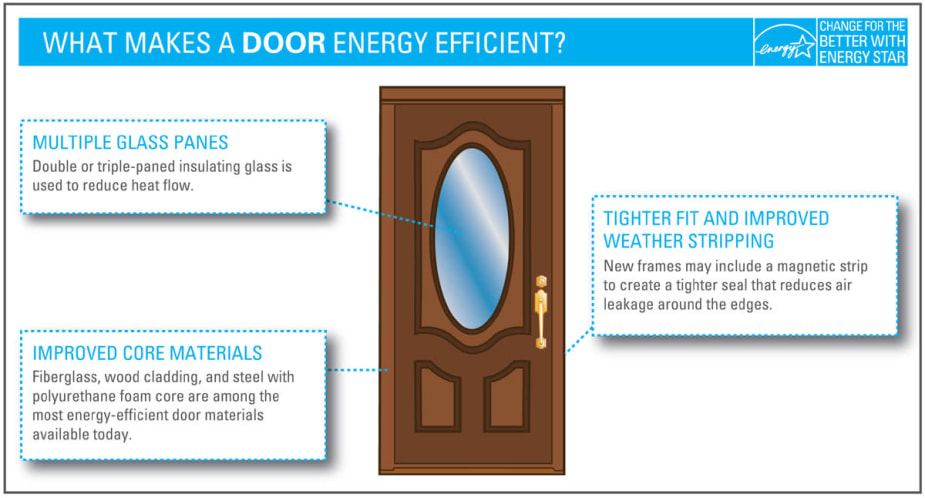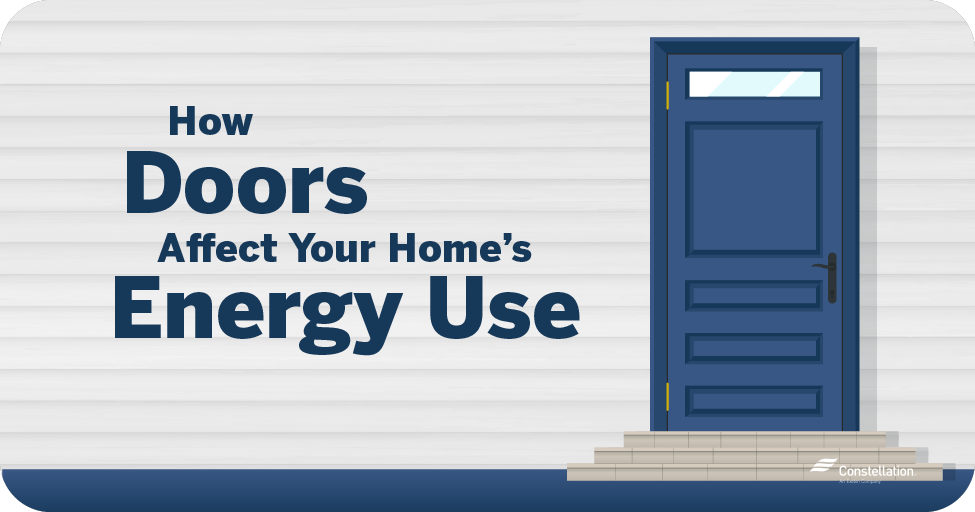Brief overview of the importance of energy efficiency in homes
Energy efficiency in homes is crucial for reducing energy consumption and costs. When it comes to doors, energy-efficient options play a significant role in minimising heat loss, air leakage, and the need for excessive heating or cooling. According to the Energy Saving Trust, energy-efficient glazing in doors reduces heat loss, fewer draughts, and cold spots.
Furthermore, energy-efficient doors play a significant role increasing the value of homes and contributing to a greener environment by lowering carbon emissions. By installing energy-efficient glazing and high thermal performance doors, heat loss is reduced, homes are kept warmer, and heating bills are lowered.
Introduction to the role of doors in enhancing energy efficiency
Additionally, home’s exterior doors can contribute to air leakage and waste energy through conduction, especially if they are old, uninsulated, or improperly installed.Therefore, investing in energy-efficient doors not only benefits homeowners financially but also helps in environmental conservation and reducing energy waste.
Energy-efficient doors play a crucial role in enhancing the energy efficiency of homes. They help reduce total energy consumption by preventing heat loss and minimising air leakage, ultimately leading to lower utility bills and a reduced carbon footprint.
The energy efficiency of doors is measured by how much heat is lost through the door compared to how much heat it prevents from escaping.
By selecting doors with high energy performance ratings and proper insulation, homeowners can significantly improve the overall energy efficiency of their home. Upgrading to energy-efficient doors not only adds value to the property but also contributes to a more sustainable and environmentally friendly lifestyle.
Why Choose Green Doors?
- Significant Energy Savings
- Security
- Eco-Friendly
- Increased property value
Explanation of green doors and their energy-saving features
Energy-efficient doors, also known as green doors, are designed to minimise heat loss and air leakage, thus reducing energy consumption and lowering utility bills. These doors are constructed using insulating materials or composites and feature an airtight seal to prevent heat from escaping and cold air from entering. Some energy-efficient doors also utilise glass to harness natural heat from the sun, further enhancing their thermal performance. In addition to their energy-saving features, these doors are often made from environmentally friendly materials to minimise their impact on the environment. By choosing energy-efficient doors, homeowners can create a warm and comfortable living environment, reduce their energy usage, and contribute to environmental conservation.
Environmental benefits of energy-efficient homes
The use of energy-efficient doors offers significant environmental benefits. By minimising heat loss and air leakage, these doors contribute to lower energy consumption, resulting in a reduced carbon footprint and a positive impact on the environment. Additionally, energy-efficient doors are often constructed with sustainable materials and advanced insulation, which not only reduces the need for constant heating and cooling but also leads to a more stable indoor temperature, further lowering energy usage and environmental impact. Furthermore, by investing in energy-efficient doors, homeowners can play a part in environmental conservation and contribute to a more sustainable and eco-friendly lifestyle.
Cost savings associated with green doors over time
Energy-efficient doors offer significant cost savings over time. While the initial investment may be higher, the long-term durability of energy-efficient doors translates to lower maintenance costs and a higher return on investment. By minimising heat loss and air leakage, these doors reduce the need for constant heating and cooling. Additionally, the use of energy-efficient doors can result in substantial energy savings, as they are designed to seal tightly and prevent air leaks, thus reducing the amount of energy essential to heat or cool a home.

Understanding Energy Efficiency In Doors Helping You Choose the Right Energy Efficient Door for Your Home
Insulation properties and their impact on energy conservation
When selecting an energy-efficient door, it’s essential to consider several factors. While the door type holds significance, it’s equally crucial to be mindful of the technical specifications.
The insulation properties of doors play a significant role in energy conservation. Here are the specific factors and their impact:
U-Values
U-Values measure a door’s heat transfer rate; lower values indicate better insulation. Opting for doors with lower U-Values ensures improved thermal performance. When selecting a door, prioritise those with low U-Values. However, it’s important to note that not all door products offer the same level of insulation performance. For instance, a solid wooden door might have a U-Value of 3.0W, while a uPVC door could boast a U-Value of 1.8W – making the uPVC door the more energy-efficient choice.
Understanding Energy Ratings
Energy ratings, graded from ‘A++’ to ‘G,’ consider factors like U-Value, solar gain, and air leakage. Higher ratings indicate superior energy efficiency.

The British Fenestration Rating Council (BFRC) introduced energy ratings to provide consumers with a more easily understood and recognized assessment. This rating system evaluates the overall energy performance of a door, considering factors such as U-Value, solar gain, and air leakage.
We are accustomed to encountering ‘A-G’ classifications for electrical appliances like fridges, washing machines, cookers, and various household items. This same grading system is now applied to doors. The energy efficiency of a door product is expressed through a traffic light rating ranging from ‘A’ to ‘G.’ An ‘A+’ rating signifies an outstanding level of energy efficiency (‘A++’ being the highest possible), while ‘G’ indicates the lowest efficiency.
Glazing
The efficiency of glazing in conserving energy hinges on three key factors:
- The extent to which light and heat are allowed in.
- The amount of heat that can escape.
- The airtightness of the glazing unit.
External doors come in various forms: solid, partially glazed, or fully glazed. Doors with partial or full glazing are typically double or triple glazed, incorporating a thermal barrier between the glass panes. These glazing units contain air or inert gases like argon, serving as insulation to prevent heat transfer.
When opting for a door with glazing, it is essential to ensure it is double or triple glazed. This provides dual protection against adverse weather conditions, effectively reducing drafts and cold spots to retain warmth within your home. For more detailed information, the door manufacturer is the ideal point of contact.

Minimum Energy Efficiency Standards
Building Regulations requirements:
All new doors fitted in residential new builds in England & Wales must have a U-Value not exceeding 1.8W/m2K, and the lower level of 1.6W/m2K in Scotland.
- A high performance energy-efficient door will have a minimum energy rating of ‘C’ and above. It is advisable to avoid doors with a rating of ‘D’ or below.
The following information is summarised from Building Regulations Documents L1A (New Dwellings) 2010 & L1B (Existing Dwellings) 2010.
| Fitting | Standard for Fittings in New Dwellings | Standard for Replacement Fittings in Existing Dwellings |
| Doors (more than 50% of their internal face glazed) – England & Wales | 1.8W/m2K | 1.8W/m2K (exempt if fitted into existing door frame) |
| Doors (more than 50% of their internal face glazed) – Scotland | 1.8W/m2K | 1.6W/m2K (exempt if fitted into existing door frame) |
Types of Energy-Efficient Doors:
Insulated Metal Doors:
Pros: High energy efficiency, strength, durability, weather resistance, low maintenance.
Cons: Prone to scratches, may require stronger hinges.
Insulated uPVC Doors:
Pros: Energy efficiency, eco-friendly, minimal maintenance.
Cons: Susceptible to warping in extreme weather, basic style.
Wooden Doors:
Pros: Natural insulation, eco-friendly, customizable.
Cons: Regular maintenance, potential for warping, higher cost.
Insulated Composite Doors:
Pros: Enhanced energy efficiency, weather resistance, strength, low maintenance.
Cons: Higher cost, potential for cracking in hot weather.
DIY Installation Tips
For those comfortable with home improvement projects, here are some tips for installing an energy-efficient door:
- Preparation: Measure the door frame accurately and ensure it fits properly. Use a level to check that the door is plumb and level throughout the installation.
- Tools: You will need a measuring tape, level, screwdrivers, drill, and other basic tools for the installation.
- Weatherstripping: Install weather-stripping to improve the door’s energy efficiency and prevent drafts.
- Threshold Installation: If the door requires a threshold or a sill, make sure it is installed properly.
- Finishing Touches: Add decorative elements to enhance the functionality, durability, and aesthetics of the new door.
Professional Installation Considerations
For those seeking expert assistance, professional installation offers the following benefits:
Optimal Energy Efficiency: Professional fitters can ensure that the door’s energy efficiency is optimised, leading to long-term cost savings.
Long Lifespan: Expert installation can contribute to the door’s long lifespan and overall performance.
Peace of Mind: Professional installation provides peace of mind and ensures that the door is installed with precision and care.
By weighing the complexity of the installation and personal expertise, homeowners can decide whether to pursue a DIY approach or seek professional assistance for the installation of energy-efficient doors.
The Energy-Efficient Revolution: Upgrade Your Home
In addition to revolving doors, other eco-friendly window and door options also play a crucial role in enhancing the energy efficiency of homes and buildings. Features such as smart window technology, solar-ready designs, and enhanced insulation and waterproofing contribute to reducing energy consumption and promoting sustainability. These options not only align with the growing emphasis on environmental responsibility but also offer tangible benefits in terms of energy conservation and reduced carbon footprint.
The importance of embracing energy-efficient solutions, including green doors, is further underscored by the emergence of ambitious new targets for a green building revolution. These targets are designed to lower energy consumption and contribute to environmental protection, affecting both existing and new homes and businesses. Therefore, the integration of energy-efficient elements, such as green doors, is becoming increasingly essential for individuals and organisations seeking to align with these evolving standards and make a positive impact on the environment.
Frequently Asked Questions (FAQs)
1. What makes a door energy-efficient?
To make a door energy-efficient, key features such as insulation, high-quality materials, and effective weather-stripping are essential to prevent air leakage and maintain indoor temperature.
2. How do green doors contribute to a sustainable home?
Green doors contribute to a sustainable home by reducing energy consumption, lowering carbon footprint, and using eco-friendly materials, leading to positive environmental impacts.
3. Are green doors more expensive than traditional doors?
The initial cost of green doors may be higher, but they offer long-term savings through reduced energy bills and lower maintenance costs, making them cost-effective in the long run
4. What materials are commonly used in energy-efficient doors?
Common materials used in energy-efficient doors include fibreglass, steel, wood, and insulating composites, each offering unique benefits for energy efficiency and durability
5. Can energy-efficient doors be stylish and aesthetically pleasing?
Energy-efficient doors can be stylish and aesthetically pleasing, with a variety of materials, styles, and sizes available to match the overall aesthetic of the property.
6. Do energy-efficient doors require special maintenance?
While energy-efficient doors generally require minimal maintenance, specific care tips may vary based on the door’s material, such as steel, uPVC, wood, or composite.7. How do green doors contribute to home resale value?
Green doors can enhance home resale value by attracting environmentally conscious buyers and offering long-term cost savings on energy bills.
8. Can I install green doors myself, or do I need a professional?
The installation of green doors can be done by professionals or as a DIY project, with considerations for the complexity of the installation and the specific door type.
